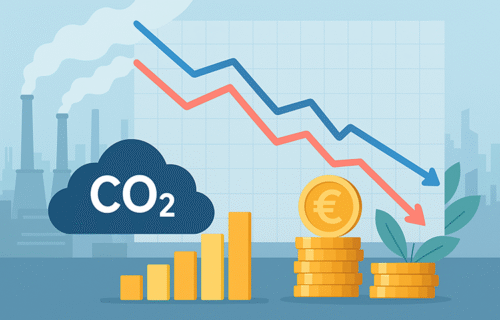The European Securities and Markets Authority (ESMA) has reported a year of adjustment in the EU carbon market, with emission allowance prices dropping sharply in 2024 due to lower demand from power producers and a rise in auctioned volumes. Despite this, trading activity expanded significantly, driven by financial institutions, while the overall market remained stable and transparent.
According to ESMA’s EU Carbon Markets Report 2025, the average price of EU emission allowances (EUAs) fell by 22%, averaging €65 per tonne of CO₂, compared with €83 in 2023. Prices reached a low of €51 per tonne in February before recovering slightly and stabilising between €60 and €75 for the rest of the year. The fall reflected the ongoing shift toward renewable energy, which cut emissions from electricity generation by 12% and pushed verified emissions under the EU Emissions Trading System (ETS) down 5% overall.
At the same time, auction volumes rose 15% to 599 million allowances, generating €39 billion in revenue. The increase was part of the EU’s REPowerEU programme, which accelerates funding for energy transition projects. All auctions were oversubscribed, though the average cover ratio fell to 172% (down from 202% in 2023), showing less competitive pressure as supply expanded. Around 90% of all allowances were acquired by just ten firms, mostly financial intermediaries, with German entities leading purchases.
Trading volumes grew 35% year-on-year, reaching 13.7 billion tonnes of CO₂-equivalent exchanged across 4.7 million transactions. Most activity took place on regulated exchanges such as ICE Endex and the European Energy Exchange, while over-the-counter (OTC) trading remained steady at about 10% of total volume. Investment firms and banks dominated the market, handling about 63% of total trading, up seven percentage points from the previous year.
Derivative markets remained crucial to the functioning of the EU ETS, supporting the transfer of allowances from financial players to companies with compliance obligations. Futures contracts represented three-quarters of all trades, while options grew modestly. Open interest in derivatives rose sharply toward the end of 2024, peaking at around €200 billion before December contract expirations.
The report also highlights growing sophistication among non-financial participants. Utility companies held the largest long positions, mainly as hedges for emissions compliance, while commodity trading firms engaged more actively in short-term speculative trading. Transportation companies and industrial producers continued to rely on bilateral contracts for emissions coverage.
ESMA found no evidence of market manipulation or integrity breaches during the reporting period. However, it reiterated its call for greater transparency through the wider adoption of Legal Entity Identifiers (LEIs) within the EU ETS registry. Only 16% of new account holders introduced the identifier in 2024, which ESMA says limits effective monitoring of cross-border trades and counterparty risk.
The regulator also urged progress on aligning data reporting standards under the MiFIR and EMIR frameworks, aiming to simplify compliance and improve data consistency across markets.
While the carbon market experienced its sharpest price correction since the pandemic, ESMA noted that structural trends — such as continued decarbonisation, renewable investment, and a maturing derivatives segment — are laying the groundwork for longer-term stability.
